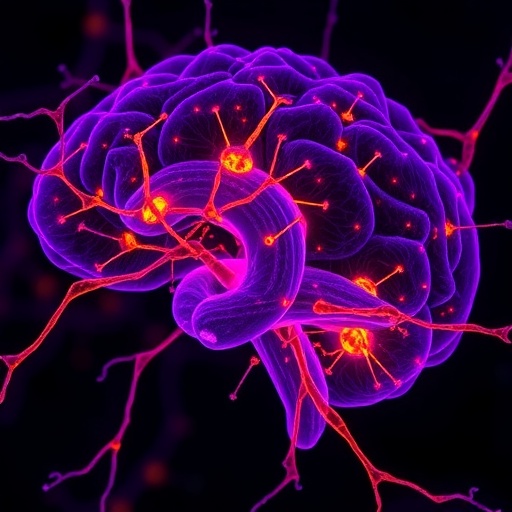In a groundbreaking study led by researchers Wang, Y., Li, S., and Zhang, C., the team has revealed a potential therapeutic approach that harnesses adeno-associated virus (AAV) technology to express the STC-1 protein in the context of degenerative retinopathy. This innovative strategy aims to mitigate neuroinflammation, a primary contributor to visual impairment in degenerative diseases, and ultimately help preserve visual function. The findings hold significant implications for the treatment of patients suffering from retinal degenerative conditions, which have remained challenging to address with conventional therapies.
Retinal degenerative diseases, including age-related macular degeneration and diabetic retinopathy, pose a significant threat to vision, leading to irreversible blindness in many cases. These conditions are characterized by progressive neurodegeneration, inflammation, and dysfunction of retinal cells. The role of neuroinflammation in exacerbating these conditions has attracted increasing interest from researchers. Understanding and targeting this inflammatory process could revolutionize therapeutic approaches, enabling better management and potential restoration of vision for affected patients.
Central to the researchers’ approach is the use of AAV, a validated vector for gene therapy applications. AAVs are known for their safety profile, efficiency in delivering therapeutic genes, and ability to induce long-lasting effects. By engineering AAVs to carry the gene encoding STC-1, the researchers aimed to enhance its expression in retinal cells, mitigating the inflammatory response that characterizes degenerative retinopathy. This strategy not only addresses inflammation but also aims to restore normal cellular functions affected by the disease.
STC-1 (Stanniocalcin-1) has been identified as a key neuroprotective factor, playing a pivotal role in cellular responses to stress. Its ability to regulate apoptosis, promote cell survival, and modulate inflammatory pathways makes it an attractive target for therapeutic intervention. This study systematically investigated the mechanisms through which STC-1 exerts its protective effects in retinal cells, providing vital insights into its potential as a therapeutic agent for retinopathy.
In the experimental phase, the team employed advanced in vitro and in vivo models to assess the efficacy of AAV-mediated STC-1 expression. Using retinal cells derived from animal models of degenerative retinopathy, the researchers demonstrated that STC-1 expression led to significant reductions in markers of neuroinflammation. This was a pivotal step, as it suggested that elevating STC-1 levels could potentially counteract the destructive inflammatory processes that underlie vision loss in these patients.
Additionally, the study indicated that the preservation of visual function was significantly improved in the animal models treated with AAV-STC-1 compared to control groups. Behavioral tests assessing visual acuity and response to stimuli provided compelling evidence of better-preserved visual capabilities in the treated cohort. These results underscore the potential of gene therapy to not only halt disease progression but also enhance the quality of life for individuals facing degenerative retinal disorders.
The implications of these findings extend beyond the confines of laboratory research. As the prevalence of retinal degenerative diseases continues to rise with aging populations, a novel therapeutic approach could alleviate the burden of disability and loss of independence that accompanies vision impairment. The scientific community and, more importantly, patients eagerly await further developments in the translation of this promising therapy into clinical settings.
Moreover, the research team is optimistic about the scalability of this therapeutic strategy. Future studies will focus on fine-tuning the AAV vectors to optimize their delivery and expression of STC-1. By enhancing the specificity of the vector targeting retinal cells, the team aims to reduce potential off-target effects, thereby increasing the overall safety and efficacy of the treatment in human clinical trials.
As the discussion surrounding gene therapy escalates, this study positions AAV-mediated STC-1 expression at the forefront of innovative treatment strategies for degenerative retinopathy. The findings contribute to a growing body of literature emphasizing the role of gene therapy in addressing complex diseases, providing hope and a path forward for patients with limited options.
In conclusion, the research spearheaded by Wang, Li, and Zhang marks a significant leap in our understanding of how gene therapy can be harnessed to combat neuroinflammation and preserve visual function. The potential to improve the lives of millions living with degenerative retinal diseases underlines the importance of continued research and clinical trials in this promising field. As we anticipate further studies, the hope of restoring sight and mitigating the impact of these debilitating conditions becomes increasingly tangible.
Overall, this research paves the way for a new era in ophthalmology, where innovative therapies inspired by genetic and molecular insights may soon become the standard of care in managing retinal degenerative diseases, ensuring that patients can maintain their vision and quality of life for as long as possible.
Subject of Research: Gene therapy using AAV-mediated STC-1 expression to combat neuroinflammation in degenerative retinopathy.
Article Title: AAV-mediated STC-1 expression mitigates neuroinflammation and preserves visual function in degenerative retinopathy.
Article References:
Wang, Y., Li, S., Zhang, C. et al. AAV-mediated STC-1 expression mitigates neuroinflammation and preserves visual function in degenerative retinopathy.
J Transl Med 23, 924 (2025). https://doi.org/10.1186/s12967-025-06898-1
Image Credits: AI Generated
DOI: 10.1186/s12967-025-06898-1
Keywords: Gene therapy, AAV, STC-1, degenerative retinopathy, neuroinflammation, visual function, translational medicine.




